
Long-tailed Thrush Zoothera dixoni
Etymology:
- Zoothera : Greek word zoon animal; theras –hunter
- Dixoni : Named after British zoologist Charles Dixon (1858–1926)
Distribution : Resident in Central & East Himalayas (Eastwards from Uttarakhand) ; winter visitor in North East India (South of River Brahmaputra)
Description : Size of 25–27 cm; wt. of 71–125 g. It is plain warm olive-brown above from crown to tail, with whitish eyering, buffy face marked dark below eye, on rear ear-coverts and on malar. It has two buff-spotted wingbars. It is buffy-white below, with fairly dense black crescents from lower throat to lower belly, undertail-coverts are creamy-buff; bill is dark; legs are flesh-coloured. Both the sexes are similar. Immature has buff shaft streaks from nape to scapulars.
Habitat: It is found in reeds in dense fir, juniper and birch-rhododendron forest,. It is found at 3000 m–4200 m. In winter it dwells in dense forest, open bushy country and second growth at 1500–3000 m.
Food habits: It eats Invertebrates. It is largely terrestrial, foraging along leafy tracks and roadsides. It is found in small flocks in non-breeding season; occurs in mixed thrush flocks.
Breeding habits: They breed in May–Jul in Himalayas. The nest is a large cup of twigs and moss, lined with grass, placed in low tree. They lay a clutch of 2-3 eggs.